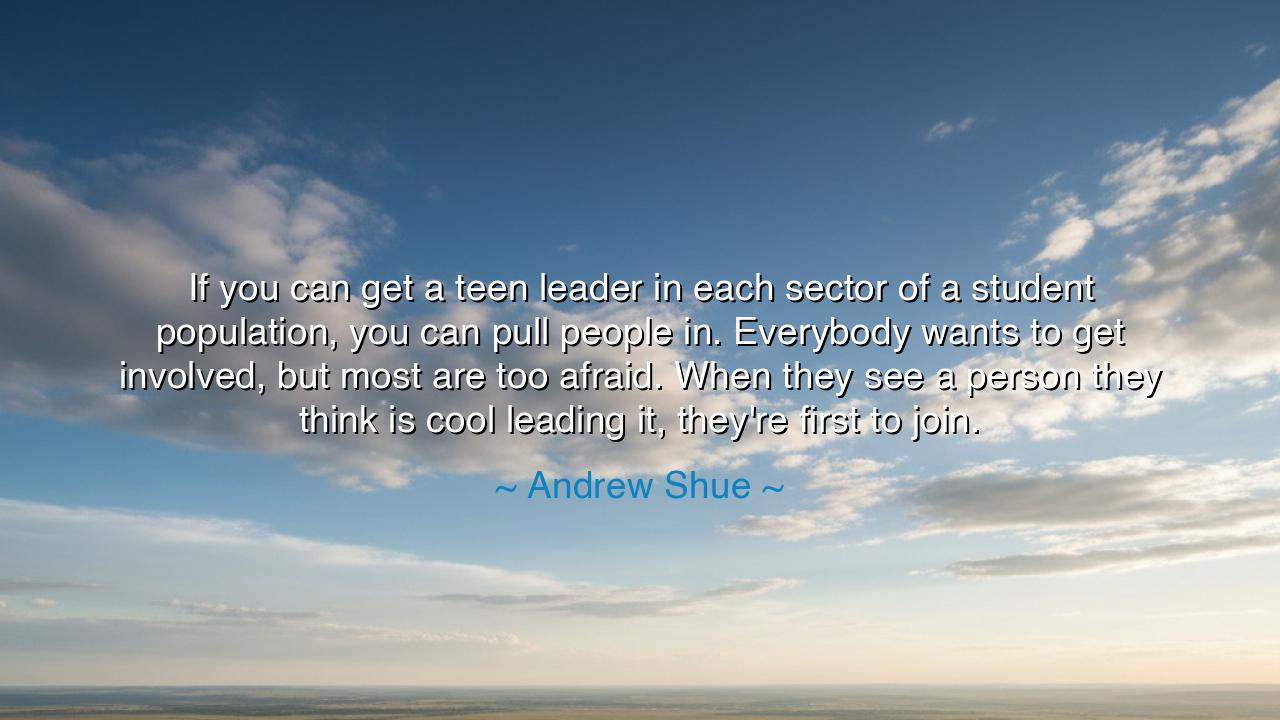
If you can get a teen leader in each sector of a student
If you can get a teen leader in each sector of a student population, you can pull people in. Everybody wants to get involved, but most are too afraid. When they see a person they think is cool leading it, they're first to join.






In the grand design of any community, there exists a profound truth: leadership is the beacon that draws others from the darkness of hesitation into the light of action. Andrew Shue, in his wisdom, speaks to the power of the teen leader—the one who can ignite the spark of engagement and inspire others to join a cause. "If you can get a teen leader in each sector of a student population, you can pull people in." These words carry the essence of visionary leadership, reminding us that true leadership is not merely about commanding others, but about inspiring them to take their first step into action.
The ancients understood that influence was the true power of any ruler or leader. The great emperors and philosophers did not merely rule with fear or authority—they led with the power of their example. In ancient Rome, Julius Caesar was not just a general of great military prowess, but a leader who understood the importance of symbolism and the power of personal charisma. His presence alone inspired soldiers to follow him into battles that seemed insurmountable. Just as Caesar’s influence pulled men into action, so too can a teen leader, with the force of their example, lead others to step out of their comfort zones.
Shue’s statement that “everybody wants to get involved, but most are too afraid,” speaks to the universal human condition. From the humblest peasant to the mightiest king, fear has always been the barrier that separates the willing from the unwilling, the brave from the cautious. Fear keeps people from stepping forward, from expressing their true potential. It is only when they see someone they admire—someone they deem cool, someone they can relate to—that they find the courage to step out from the shadows. Andrew Shue points to the crucial role that peer leadership plays in overcoming this barrier. It is not the mighty or the exalted who are always the best leaders, but those who speak the language of their peers, who share in their struggles and triumphs.
Consider the civil rights movement of the 1960s, where young leaders, like John Lewis, led marches, protests, and sit-ins, inspiring a generation to stand up for their rights. John Lewis was not an elderly sage or a figurehead of a distant cause; he was a young man, in his early twenties, who spoke directly to the hearts of his peers. His leadership was not just a call to action, but an invitation for others to join in a movement that was larger than themselves. He, like the teen leader Shue speaks of, became the face of courage that others wanted to follow.
The ancient world tells of many such heroes—leaders whose charisma and actions became the rallying cry for their people. Alexander the Great, in his youth, captivated the hearts of his soldiers not through mere fear, but through a vision of conquest that was shared by all. He led not just by the sword, but by inspiring his soldiers with the belief that they were part of something great, something worthwhile. It was this inspiration that drove them forward, across lands and seas, toward an uncertain future. Like Shue’s teen leader, Alexander drew others in by making them believe that they, too, could be a part of something transformative.
Andrew Shue’s words highlight the power of connection. When a leader is relatable, when they embody the dreams, hopes, and challenges of their followers, they become the catalyst for change. A teen leader, not too distant in age or experience, is uniquely positioned to understand the fears and desires of their peers. By leading through example, by showing others that it is okay to be vulnerable and brave, they remove the fear that holds others back. They serve as the embodiment of possibility, a living example that says, “If I can do it, so can you.”
The lesson to be learned is simple, yet profound: leadership is not always about strength or authority; it is about connection, understanding, and inspiration. If we are to lead, we must first understand the fears and dreams of those we seek to guide. We must meet them where they are, not from a distance, but beside them. The true power of a leader lies in their ability to empower others—to help them see that they, too, can be part of something greater than themselves. Whether it is in the realm of school, work, or life itself, let us strive to be leaders who inspire through connection, understanding, and example. And in doing so, we will create a future where others are not afraid to step forward and become the leaders of tomorrow.






AAdministratorAdministrator
Welcome, honored guests. Please leave a comment, we will respond soon